7 books about Water-supply, Agricultural

Agricultural Development in Japan
The Land Improvement District in Concept and Practice
Gil Latz
University of Chicago Press, 1989
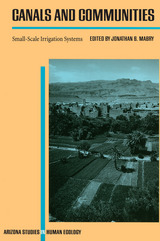
Canals and Communities
Small-Scale Irrigation Systems
Jonathan B. Mabry
University of Arizona Press, 1996
From the mountains of South America to the deserts of northern Africa to the islands of south Asia, people have devised myriad ways of moving water to sustain their communities and nourish their crops. Many of these irrigation methods have been used over long periods of time and continue to function in diverse ecological and sociopolitical contexts. This book presents case studies and comparative essays about local institutions for managing water resources. Drawn from around the globe, the cases clearly demonstrate that "indigenous" irrigation is often more sustainable, cost-effective, and flexible than has been generally believed. The contributors discuss a wide range of environments, cultural traditions, and historical contexts in which such systems operate, maintaining a common focus on incentives for cooperation, operational rules, collective-choice arrangements, principles of allocation, and conflict-resolution mechanisms. Canals and Communities can serve as a sourcebook for social scientists and development planners investigating the cultural ecology of irrigated agriculture, the ethnology of cooperative social formations, the politics of collective-resource institutions, and the sociology of rural development. The book also provides examples and generalizations about the cross-cultural characteristics of sustainable water resource management and intensive agriculture. Aside from its theoretical contributions to human ecology and anthropology, the book is of practical importance to development studies. The cases it presents make a convincing argument for perpetuating small-scale irrigation systems as part of the world's repertoire of irrigation knowledge and resources.
CONTENTS
Introduction
The Ethnology of Irrigation: Cross-Cultural Characteristics of Local Water Management, Jonathan B. Mabry
Patterns of Cooperation and Conflict in Local Irrigation
1. La Gente es Muy Perra: Conflict and Cooperation over Irrigation Water in Cucurpe, Sonora, Mexico, Thomas E. Sheridan
2. Dhasheeg Agriculture in the Jubba Valley of Somalia, Catherine Besteman
3. The Dry and the Drier: Cooperation and Conflict in Moroccan Irrigation, John R. Welch
4. The Political Ecology of Irrigation in an Andean Peasant Community, Paul H. Gelles
Methods and Models for Analyzing Local Irrigation
5. Rapid Rural Appraisal of Arid Land Irrigation: A Moroccan Example, John R. Welch, Jonathan B. Mabry, and Hsain Ilahiane
6. Simulation Modelling of Balinese Irrigation, J. Stephen Lansing
7. Institutional Innovation in Small-Scale Irrigation Networks: A Cape Verdean Case, Mark W. Langworthy and Timothy J. Finan
Development Lessons from Local Irrigation
8. Qanats and Rural Societies: Sustainable Agriculture and Irrigation Cultures in Contemporary Iran, Michael E. Bonine
9. The Utility of Tradition in Sri Lankan Bureaucratic Irrigation: The Case of the Kirindi Oya Project, Pamela Stanbury
10. The Relevance of Indigenous Irrigation: A Comparative Analysis of Sustainability, Jonathan B. Mabry and David A. Cleveland
Conclusion
The Hydraulics of History: Evolutionary Trajectories of Local and Centralized Irrigation, Jonathan B. Mabry
CONTENTS
Introduction
The Ethnology of Irrigation: Cross-Cultural Characteristics of Local Water Management, Jonathan B. Mabry
Patterns of Cooperation and Conflict in Local Irrigation
1. La Gente es Muy Perra: Conflict and Cooperation over Irrigation Water in Cucurpe, Sonora, Mexico, Thomas E. Sheridan
2. Dhasheeg Agriculture in the Jubba Valley of Somalia, Catherine Besteman
3. The Dry and the Drier: Cooperation and Conflict in Moroccan Irrigation, John R. Welch
4. The Political Ecology of Irrigation in an Andean Peasant Community, Paul H. Gelles
Methods and Models for Analyzing Local Irrigation
5. Rapid Rural Appraisal of Arid Land Irrigation: A Moroccan Example, John R. Welch, Jonathan B. Mabry, and Hsain Ilahiane
6. Simulation Modelling of Balinese Irrigation, J. Stephen Lansing
7. Institutional Innovation in Small-Scale Irrigation Networks: A Cape Verdean Case, Mark W. Langworthy and Timothy J. Finan
Development Lessons from Local Irrigation
8. Qanats and Rural Societies: Sustainable Agriculture and Irrigation Cultures in Contemporary Iran, Michael E. Bonine
9. The Utility of Tradition in Sri Lankan Bureaucratic Irrigation: The Case of the Kirindi Oya Project, Pamela Stanbury
10. The Relevance of Indigenous Irrigation: A Comparative Analysis of Sustainability, Jonathan B. Mabry and David A. Cleveland
Conclusion
The Hydraulics of History: Evolutionary Trajectories of Local and Centralized Irrigation, Jonathan B. Mabry
[more]
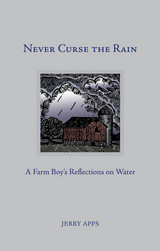
Never Curse the Rain
A Farm Boy’s Reflections on Water
Jerry Apps
Wisconsin Historical Society Press, 2017
Growing up on the family farm, Jerry Apps learned from a young age that water was precious. The farm had no running water, a windmill pumped drinking water for the small herd of cattle, and Jerry and his brothers hauled bucket after bucket of water for the family’s use. A weekly bath was considered sufficient. And when it rained, it was cause for celebration. Indeed, if ever the Apps boys complained about a rainy day spoiling their plans, their father admonished, "Never curse the rain," for the family’s very livelihood depended upon it.
In Never Curse the Rain, Jerry shares his memories of water, from its importance to his family’s crops and cattle to its many recreational uses—fishing trips, canoe journeys, and the simple pleasures of an afternoon spent dreaming in the haymow as rain patters on the barn roof. Water is still a touchstone in Jerry’s life, and he explores the ways he’s found it helpful in soothing a troubled mind or releasing creativity. He also discusses his concerns about the future of water and ensuring we always have enough. For, as Jerry writes, "Water is one of the most precious things on this planet, necessary for all life, and we must do everything we can to protect it."
In Never Curse the Rain, Jerry shares his memories of water, from its importance to his family’s crops and cattle to its many recreational uses—fishing trips, canoe journeys, and the simple pleasures of an afternoon spent dreaming in the haymow as rain patters on the barn roof. Water is still a touchstone in Jerry’s life, and he explores the ways he’s found it helpful in soothing a troubled mind or releasing creativity. He also discusses his concerns about the future of water and ensuring we always have enough. For, as Jerry writes, "Water is one of the most precious things on this planet, necessary for all life, and we must do everything we can to protect it."
[more]
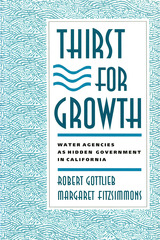
Thirst for Growth
Water Agencies as Hidden Government in California
Robert Gottlieb
University of Arizona Press, 1991
An overview of the key issues of public accountability and water policy innovation that confront urban and agricultural water agencies throughout the country--notably in California where the prospects for future water development have become especially problematic. Focusing on six agencies in the Southern California region, they offer a series of case studies analyzing the issues of water quality, including groundwater contamination and disinfection by-products; reallocation and transfer of existing supplies; and management programs based on pricing changes, the conjunctive use of surface and groundwater supplies, and increased storage capacity aimed at greater efficiencies in stretching those existing supplies.
[more]
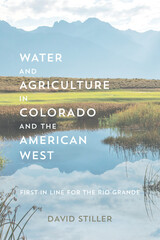
Water and Agriculture in Colorado and the American West
First in Line for the Rio Grande
David Stiller
University of Nevada Press, 2021
Water has always been one of the American West’s most precious and limited resources. The earliest inhabitants—Native Americans and later Hispanics—learned to share the region’s scant rainfall and snowmelt. When Euro-Americans arrived in the middle of the nineteenth century, they brought with them not only an interest in large-scale commercial agriculture but also new practices and laws about access to, and control of, the water essential for their survival and success. This included the concept of private rights to water, a critical resource that had previously been regarded as a communal asset.
David Stiller’s thoughtful study focuses on the history of agricultural water use of the Rio Grande in Colorado’s San Luis Valley. After surveying the practices of early farmers in the region, he focuses on the impacts of Euro-American settlement and the ways these new agrarians endeavored to control the river. Using the Rio Grande as a case study, Stiller offers an informed and accessible history of the development of practices and technologies to store, distribute, and exploit water in Colorado and other western states, as well as an account of the creation of water rights and laws that govern this essential commodity throughout the West to this day. Stiller’s work ranges from meticulously monitored fields of irrigated alfalfa and potatoes to the local and state water agencies and halls of Congress. He also includes perceptive comments on the future of western water as these arid states become increasingly urbanized during a period of worsening drought and climate change.
An excellent read for anyone curious about important issues in the West, Water and Agriculture in Colorado and the American West offers a succinct summary and analysis of Colorado’s use of water by agricultural interests, in addition to a valuable discussion of the past, present, and future of struggles over this necessary and endangered resource.
David Stiller’s thoughtful study focuses on the history of agricultural water use of the Rio Grande in Colorado’s San Luis Valley. After surveying the practices of early farmers in the region, he focuses on the impacts of Euro-American settlement and the ways these new agrarians endeavored to control the river. Using the Rio Grande as a case study, Stiller offers an informed and accessible history of the development of practices and technologies to store, distribute, and exploit water in Colorado and other western states, as well as an account of the creation of water rights and laws that govern this essential commodity throughout the West to this day. Stiller’s work ranges from meticulously monitored fields of irrigated alfalfa and potatoes to the local and state water agencies and halls of Congress. He also includes perceptive comments on the future of western water as these arid states become increasingly urbanized during a period of worsening drought and climate change.
An excellent read for anyone curious about important issues in the West, Water and Agriculture in Colorado and the American West offers a succinct summary and analysis of Colorado’s use of water by agricultural interests, in addition to a valuable discussion of the past, present, and future of struggles over this necessary and endangered resource.
[more]
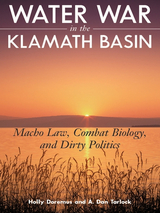
Water War in the Klamath Basin
Macho Law, Combat Biology, and Dirty Politics
Holly Doremus and A. Dan Tarlock
Island Press, 2008
In the drought summer of 2001, a simmering conflict between agricultural and environmental interests in southern Oregon’s Upper Klamath Basin turned into a guerrilla war of protests, vandalism, and apocalyptic rhetoric when the federal Bureau of Reclamation shut down the headgates of the Klamath Project to conserve water needed by endangered species. This was the first time in U.S. history that the headgates of a federal irrigation project were closed—and irrigators denied the use of their state water rights—in favor of conservation. Farmers mounted a brief rebellion to keep the water flowing, but ultimately conceded defeat.
In Water War in the Klamath Basin, legal scholars Holly Doremus and A. Dan Tarlock examine the genesis of the crisis and its fallout, offering a comprehensive review of the event, the history leading up to it, and the lessons it holds for anyone seeking to understand conflicts over water use in the arid West. The authors focus primarily on the legal institutions that contributed to the conflict—what they call “the accretion of unintegrated resource management and environmental laws” that make environmental protection so challenging, especially in politically divided regions with a long-standing history of entitlement-based resource allocation.
Water War in the Klamath Basin explores common elements fundamental to natural resource conflicts that must be overcome if conflicts are to be resolved. It is a fascinating look at a topic of importance for anyone concerned with the management, use, and conservation of increasingly limited natural resources.
In Water War in the Klamath Basin, legal scholars Holly Doremus and A. Dan Tarlock examine the genesis of the crisis and its fallout, offering a comprehensive review of the event, the history leading up to it, and the lessons it holds for anyone seeking to understand conflicts over water use in the arid West. The authors focus primarily on the legal institutions that contributed to the conflict—what they call “the accretion of unintegrated resource management and environmental laws” that make environmental protection so challenging, especially in politically divided regions with a long-standing history of entitlement-based resource allocation.
Water War in the Klamath Basin explores common elements fundamental to natural resource conflicts that must be overcome if conflicts are to be resolved. It is a fascinating look at a topic of importance for anyone concerned with the management, use, and conservation of increasingly limited natural resources.
[more]
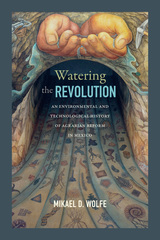
Watering the Revolution
An Environmental and Technological History of Agrarian Reform in Mexico
Mikael D. Wolfe
Duke University Press, 2017
In Watering the Revolution Mikael D. Wolfe transforms our understanding of Mexican agrarian reform through an environmental and technological history of water management in the emblematic Laguna region. Drawing on extensive archival research in Mexico and the United States, Wolfe shows how during the long Mexican Revolution (1910-1940) engineers’ distribution of water paradoxically undermined land distribution. In so doing, he highlights the intrinsic tension engineers faced between the urgent need for water conservation and the imperative for development during the contentious modernization of the Laguna's existing flood irrigation method into one regulated by high dams, concrete-lined canals, and motorized groundwater pumps. This tension generally resolved in favor of development, which unintentionally diminished and contaminated the water supply while deepening existing rural social inequalities by dividing people into water haves and have-nots, regardless of their access to land. By uncovering the varied motivations behind the Mexican government’s decision to use invasive and damaging technologies despite knowing they were ecologically unsustainable, Wolfe tells a cautionary tale of the long-term consequences of short-sighted development policies.
[more]
READERS
Browse our collection.
PUBLISHERS
See BiblioVault's publisher services.
STUDENT SERVICES
Files for college accessibility offices.
UChicago Accessibility Resources
home | accessibility | search | about | contact us
BiblioVault ® 2001 - 2024
The University of Chicago Press









